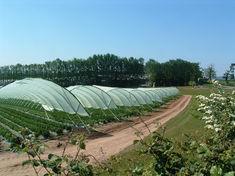
Growers living in sensitive areas where residents complain about polytunnels could be set for a boost after new trials into the feasibility of green film suggested they may be commercially viable.
The industry has been seeking ways of reducing the visual impact of polytunnels in the wake of complaints by local residents and the knock-on effect of last year’s Hall Hunter ruling.
Manufacturers bpi.visqueen and Haygrove have been developing so-called ‘landscape friendly’ films, with the first trial results suggesting that there were not substantial crop losses against clear film use.
Some people had feared that it would be impossible to replicate the success of clear tunnels with ‘camoflaged’ polythene.
The new trials have been led by Graham Moore of FAST, with the impact of the new green films tested on crops such as early season strawberries.
First to come under the microscope were Barley Green Luminance, Bright Green Clear and Dull Green Clear, both of which were compared to Classic Clear and Luminance THB. The temperature, yields and brix of the strawberries grown were examined in the trial.
While differences were noted, FAST concluded that the green landscape films did not cause substantial yield loss.
Crops under the Bright Green Clear and the Barley Green Luminance films were four days later reaching the 50 percent picked date than the crop under the Classic Clear film. Those under the Dull Green Clear and Classic Luminance film were two days later in reaching the 50 percent picked mark.
“We are still working on the statistical analysis but the raw yield data shows that two of the green films performed at least as well as the control film, Classic Clear,” explained Moore.
“Although green films are not necessarily the first choice of film for strawberry culture, it looks as if we can recommend them as an option for fields in sensitive areas without fear of substantial yield loss or quality impairment.”
Herefordshire grower Anthony Snell trialled green film on perimeter tunnels on his farm on a crop of Sonata strawberries, and reported no negative impact on the crop. “However, I find that the real value of this film is in the maintenance of good neighbourly relations,” he said.
“Our local community recognises and acknowledges the effort we have made by using this film in key roadside areas and we have received positive feedback in this respect. I would say that growers should seriously consider using green film in 10-15 percent of their operations alongside their existing film to minimise visual impact.”
But not everybody is so convinced, with some detractors suggesting that it would be impossible to grow crops to the same volume and quality using coloured films. XL Horticulture’s Les Lane believes that green film restricts the input of the red part of the spectrum, slowing the development of the crop and going against the general movement towards extending the season. l



